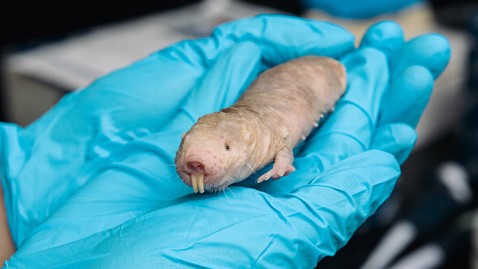
Naked mole rats may be hairless, nearly blind and – we’re just going to say it – ugly, but researchers say they have a little extra something in their skin that’s enviable: cancer-proof “goo.”
The goo could eventually lead to cancer treatment, and its discovery wouldn’t have happened if University of Rochester graduate students in upstate New York hadn’t complained to their professors that the naked mole rat cell cultures were gunking up their equipment.
“It was becoming a nuisance to the students,” University of Rochester biology professor Vera Gorbunova told ABCNews.com.
She co-authored the study in this month’s issue of science journal Nature with her husband, Andrei Seluanov, who has been her research partner for two decades.
Read about how gene therapy could treat cancer.
They had been studying the naked mole rat, which is native to East Africa and has intrigued scientists for years, because it hasn’t been known to get cancer. It also lives 30 years even though a typical of a mouse the same size only lives a maximum of four years.
Gorbunova’s and Seluanov’s students were analyzing mole rat fibroblasts, connective tissue cells that secrete collagen protein, when they discovered that the liquid containing the fibroblasts became uncommonly syrupy after a few days. It was thicker than the same culture from human, guinea pig and mouse fibroblasts.
“We told them we need to find out what this goo is,” Gorbunova said. “We had absolutely no idea where to begin.”
One student, Chistopher Pine, took it upon himself to solve the puzzle. First, he thought it was a protein, but tests revealed that protein wasn’t right.
Then, Pine tested to see whether it was hyaluronan, a molecule that gives human tissue its flexibility and promotes healing, because it plays a role in telling cells to reproduce. He treated the syrupy culture with an enzyme that would break down hyaluronan if it was there. Sure enough, once treated, the culture was no longer syrupy, proving that the goo was caused by the hyaluronan cells.
Read about how dog tumors can give clues about human breast cancer.
But the naked mole rat hyaluronan molecules were different than the human hyaluronan molecules because the human cultures didn’t turn to syrup. Gorbunova said they found that it was because the molecules were six to 10 times longer in naked mole rats than they were in humans.
Once the University of Rochester team figured out what was causing the goo, they observed naked mole rats’ cell cultures without the super-long hyaluronan molecules to see what would happen.
The naked mole rats’ cells started to grow close together, like cancer tumors. This meant the long hyaluronan molecules told cells when to stop reproducing. In other words, it prevented cancer, which is generally defined as the out-of-control growth of abnormal cells.
Eventually, the cancer-proof molecules could help treat human cancer, either by giving patients an enzyme to make them produce long hyaluronan or by simply injecting it, Gorbunova said. More research is needed.
“We were very lucky in many ways,” she said. “In my experience, the most important findings are actually when you work with something but things don’t go exactly as planned.
“We realized, wow, this goo is important.”